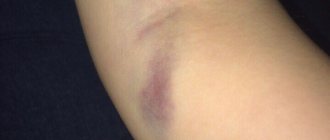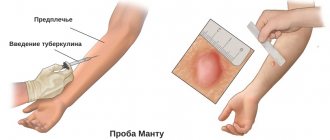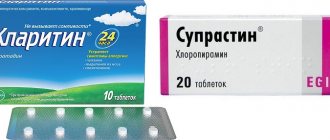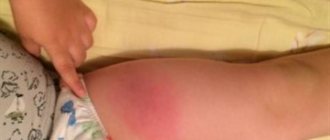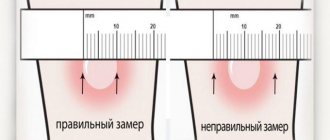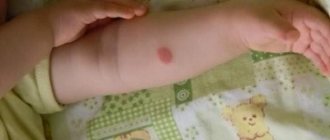Main reasons
Mantoux is not a vaccine.
This is just a test that helps determine the body’s ability to resist tuberculosis pathogens. Thanks to the test, pediatricians identify children who are infected or who need additional prophylaxis in order to prevent a serious illness. The result is assessed by the papule at the site of tuberculin injection. Its size, shape, and color can tell a qualified pediatrician a lot.
The reasons for its manifestation are the following:
- Testing without taking into account contraindications.
- The child's tendency to allergic reactions.
- Incorrect technique for performing the Mantoux test.
Most often, a bruise at the Mantoux site is formed as a result of improper vaccination. A similar reaction is common with rapid administration of tuberculin, when an accumulation of fluid forms in one place, which puts pressure on small vessels. These vessels burst, and bluish swelling appears near the papule. Sometimes blood vessels are punctured during the administration of tuberculin. And in some cases, the vaccine is given subcutaneously instead of being administered intradermally.
Why a bruise may appear in place of Mantoux
The reason that a bruise appears after Mantoux is usually an error by medical personnel. When administering tuberculin, the following incorrect actions are possible.
- During the injection, the needle hits a thin blood vessel, which bursts.
- Tuberculin is administered too quickly. At the same time, its distribution throughout the tissues is disrupted; it accumulates in one area. The accumulated fluid presses, causing damage to blood vessels.
- The needle was inserted too deeply. Then the drug gets under the skin, and a purple spot appears at the injection site.
It is important to ensure the qualifications of the health worker performing the procedure.
Why is Mantoux enlarged or bruised?
Increased Mantoux, as mentioned above, is observed not only in the presence of tuberculosis infection. The formation of bruises, itching, redness after the Mantoux test was done can be explained by the following reasons:
1. If Mantoux turned red on the first day and a hematoma formed, most likely this is not a bad Mantoux reaction, but the consequences of a poorly administered injection. When a needle damages a blood vessel, the injection site turns blue and swells, this is a natural reaction of injured tissues on day 1; on the second, the appearance of the skin usually returns to normal. In this case, the bad thing is that blue skin does not allow you to accurately determine whether there is redness and other suspicious symptoms. That’s why sometimes the doctor asks you to redo the sample after a while.
2. Allergy in a baby is another reason why Mantoux is enlarged, itchy and swollen. Usually, parents know that their child is prone to allergic reactions and inform the doctor about this before the test. Antihistamines will help reduce unpleasant symptoms and correctly evaluate the results of the Mantoux test. They begin to be taken a few days before the event and continue to be taken until the doctor’s final assessment of the results. In this case, it is better to replace the Mantoux test with Diaskintest, which usually does not cause allergies.
3. If Mantoux is swollen and itchy, the reason may be non-compliance with the regimen recommended by the doctor after the test. The injection mark should not be heated or overcooled - it is for this reason that doctors advise not to wash the child or bathe him in bodies of water. In itself, getting water on your hand is not dangerous, since the drug is injected under the skin. Exposure to high or low temperatures, chemicals penetrating the skin, trauma - this is why Mantoux itches, turns red and enlarges.
If a low-quality or expired drug was administered, the reaction may also be false. But, of course, the reasons why a child’s Mantoux is swollen, blue, and causing discomfort may be more serious.
Do's and don'ts
The first thing to do after the Mantoux test is to explain to the baby the need to follow all the instructions of the doctor or nurse.
Under no circumstances should you scratch the papule - it is important that small children understand this and not disturb such an interesting button on their arm. It is worth refusing to visit the pool, bathhouse, sauna, hot bath or shower, and you should not take a hot bath or shower until the results are assessed.
Under no circumstances should you cover the Mantoux mark with a band-aid - this will create a “greenhouse effect”, which means the result will be unreliable. It is prohibited to lubricate the button with alcohol solutions or other disinfectants, medical or cosmetic products.
If, provided that all the rules are followed and the injection is performed correctly, the Mantoux mark still turns red, swollen, or greatly enlarged, you must definitely inform your doctor about it. In case of pronounced symptoms and a sharp deterioration in the child’s well-being, doctors should be called even before 72 hours have passed after the test. In this case, self-diagnosis and self-medication are extremely dangerous, as is concealing the real results. Remember that we are talking about a serious illness that threatens not only the health, but also the life of the patient.
The Mantoux vaccination is done to get an accurate idea of the child’s health status. Tuberculosis is an insidious disease that can develop in a latent form for a long time. It is often detected using Mantoux or Diaskintest tests. Even the worst result has its positive sides - at least now you know about the disease and can begin to act. Previously, tuberculosis was only “canned”; the patient was doomed to lifelong isolation and medication. Today, pathology can be completely cured and you can live a full life, but timely detection of the disease plays a huge role.
Reasons for the increase
A large and red Mantoux does not always indicate the presence of a tuberculosis infection in the body. The final assessment of the sample should be carried out on the third day.
There may be a large Mantoux not necessarily against the background of developing tuberculosis. Why is this happening? This response of the body can be explained by many reasons:
- Tendency to allergic reactions. If parents are aware of this peculiarity of the child, then before the test and for three days after it is necessary to exclude any contact with allergens.
- Scratching the injection site or treating with medications. Sealing with a band-aid can also lead to distorted results, since sweat accumulates under it and irritates the skin.
- An enlarged Mantoux in a child may be due to a low-quality drug. Some unscrupulous manufacturers, trying to save money, use cheap raw materials with poorly purified components. If there is a suspicion of questionable quality of tuberculin, then a repeat test can be done in another medical institution.
- An inexperienced nurse may perform the Mantoux test incorrectly, which will lead to false results.
- Parents sometimes trust doctors too unconditionally, but medical professionals are human beings who can make mistakes. If a large number of Mantoux tests are passed before your eyes during the day, then by the end of the day you can, due to overwork, make a mistake with the measurements or simply use the wrong ruler for these purposes.
- Individual characteristics of the organism. An increased Mantoux reaction in such children is observed almost every time, while the lungs are in complete order. This reaction is often explained by a hereditary predisposition, when one of the relatives had the same reaction to tuberculin.
- Eating large amounts of protein foods. If a child has a great love for dairy products, meat, eggs, then three days before the Mantoux test it is advisable to limit their consumption.
- The most dangerous reason why a large papule is observed after Mantoux is infection with mycobacteria.
What to do to prevent getting a false positive result? It is important to follow all the doctor’s recommendations after the test and before the test to inform about existing pathologies and chronic diseases. If Mantoux is swollen and enlarged, then instead of panicking, you should first find out what it means
In children, many reasons can provoke a false reaction, so it is important to consult a doctor rather than listen to the advice of friends. Additional examination will be required, especially in the case of:
If Mantoux is swollen and enlarged, then instead of panicking, you should first find out what it means
In children, many reasons can provoke a false reaction, so it is important to consult a doctor rather than listen to the advice of friends. Additional examination will be required, especially in the case of:
- Recent contact with a patient with tuberculosis.
- There are people in the family or close circle who have suffered from this pathology.
- There was a visit to a region where the tuberculosis bacillus is actively widespread.
Additional diagnostics will confirm or refute the suspected diagnosis. Among the effective methods used are the following:
- For adults, fluorography, and for children, x-ray of the lungs.
- Sputum culture followed by microbiological examination.
- Pirquet's test. It consists of applying a few drops of tuberculin to the skin of the forearm. Next, the skin is incised and the result is assessed after 2-3 days. In practice, instead of this technique, a graduated Pirquet test is often used when tuberculin of different concentrations is used. A solution of sodium chloride and carbolic acid is used as a control drop. The result is also assessed after 48-72 hours.
- Enzyme immunoassay allows you to prove the presence of infection, as it shows antibodies to mycobacteria. The test is considered more reliable in regions with low incidence rates.
- PCR. The reaction is highly specific and sensitive. The method makes it possible to detect non-pulmonary forms of tuberculosis and is inexpensive and quick to obtain results.
Experts say that if an adult’s papule enlarges after the Mantoux test, then in almost 100% of cases this indicates the development of tuberculosis. But this does not exclude the need to undergo additional examination.
Tuberculosis is an insidious disease, but it can be defeated if detected at an early stage and treated with treatment.
Non-standard Mantoux reaction: bruise at the test site in a child
Mantoux is an intradermal test that gives an idea of how well the body is able to fight the causative agent of tuberculosis - tuberculin.
The sample is taken for the prevention and diagnosis of the disease in children and adults.
Bruise at the Mantoux site in a child: reasons for its appearance
Bruises are formed due to an incorrectly administered injection. Doctors can make three mistakes:
Photo 1. Bruise at the site of the Mantoux test.
As a result, the resulting bruises become a bruise.
Ways to combat blueness after testing
If you couldn’t avoid a bruise, there are ways to help eliminate it:
- try wrapping it in cling film;
- apply magnesium or cabbage leaf compress;
- anoint it with iodine.
Vaccination process and waiting time for results
The drug solution is injected into the skin of the forearm using a syringe. A blister forms at the site where the product is applied. The result is examined no earlier than 48 (ideally 72) hours after taking the sample, but no later than one week.
Important! During this period, you should follow a number of simple rules: try to avoid contact with water and other liquids, do not glue the patch on the papule, do not rub it, do not comb or disinfect the tuberculin injection site. It is recommended to remove all sweets from your diet, including fruits.
This can cause a false reaction in the body in case of predisposition and allergies. For a complete diagnosis of tuberculosis, the patient, in addition to taking a sample, undergoes a chest x-ray
It is recommended to remove all sweets from your diet, including fruits. This can cause a false reaction in the body in case of predisposition and allergies. To fully diagnose tuberculosis, the patient, in addition to taking a sample, undergoes a chest x-ray.
Photo 2. X-ray image of the lungs.
What reaction of the body can be considered normal?
Reference.
In children, the normal size of the papule can be significantly higher (up to 16 mm). After three years of age, the size of the seal should gradually change towards the normal reaction of an adult.
Important! When removing a reaction, only a dense papule is measured, but not a bruise or blue or reddened skin
Contraindications to the Mantoux test
The Mantoux test cannot be performed if:
- allergies to vaccine components (tuberculin, sodium chloride, phenol, various salts, etc.);
- skin diseases;
- chronic diseases;
- temporary somatic diseases (flu, colds);
- bronchial asthma;
- epilepsy.
Side effects: fever, rash, feeling of weakness, etc.
What could be the cause of such complications?
Reference. There is an opinion that Mantoux may be the cause of leukemia, but there is no objective scientific substantiation of this point of view.
To avoid bruising, an aseptic solution is used. The vaccine should be injected slowly into the correct location under the skin. The amount of the drug should be normalized. All operations are carried out with a clean disposable syringe with a needle of a certain length.
Attention! Adverse symptoms of the Mantoux reaction can manifest as high body temperature, increased skin sensitivity, runny nose, rash, shortness of breath, conjunctivitis, feelings of weakness, loss of appetite and allergies.
At a crossroads: Mantoux in a public institution or in a private clinic?
Mantoux is a good way to check your own health and the health of your loved ones. If you decide to get examined, but don’t know where to turn, then you will have to choose based on how much nerves, time and money you are willing to spend.
Useful video
The video explains why a bruise may appear after Mantoux and whether this will affect the test results.
Maxim - What parents of small children need to know: the norm of the Mantoux reaction at 1 year 5 Olga - Parents are worried: what should the Mantoux reaction be? The norm for children in size and color 3 Alina - It is important for any woman to know: is it possible to do fluorography during menstruation 3 Elena - Attention to parents: what not to eat after Mantoux 5 vaccination Irina - Do you urgently need another vaccination after Mantoux? How soon can this be done 5. An online magazine about tuberculosis, lung diseases, tests, diagnostics, medications and other important information about it. Online magazine about tuberculosis, lung diseases, tests, diagnostics, medications and other important information about it
Online magazine about tuberculosis, lung diseases, tests, diagnostics, medications and other important information about it
Bruise after Mantoux in a child: why it appeared at the injection site, blue button, what to do
A bruise after Mantoux in a child can occur due to violations of the rules for conducting the test: the medical worker did not use the right needle in thickness and length, injected tuberculin too shallowly, or did it too quickly. A hematoma does not pose a danger to the child’s health, but the development of an abscess and damage to nerve endings is possible - such conditions require intervention from medical professionals.
Parents, in order to avoid bruising, must follow the rules for caring for the papule for 72 hours after the test. And if you have a hematoma, you can use Magnesia lotions, Vishnevsky or Ichthyol ointment, an iodine mesh or traditional medicine, but only after consulting a doctor.
Why a bruise may appear after Mantoux in a child
A child may develop a bruise after the Mantoux test for the following reasons:
- The healthcare worker touches a small blood vessel during the injection. It bursts, causing minor hemorrhage, which leads to the formation of a bruise.
- During the injection, tuberculin was injected under the skin very quickly. In this case, the drug is unevenly distributed in the tissues and accumulates at one point. Pressure is exerted on the blood vessels, and their walls burst.
- The doctor injects tuberculin too deeply, the drug enters the subcutaneous space.
These reasons relate to medical errors and indicate that the manipulation was performed incorrectly. Also, a bruise can form if you choose a too thick needle for the Mantoux test; bluish swelling of the skin at the injection site appears when you are allergic to the injected tuberculin. A small hematoma can also appear if the rules for caring for the papule after the injection are ignored.
Despite the fact that tuberculin interacts with the blood, it cannot cause a bruise.
We recommend reading about the age at which Mantu is made. From the article you will learn how often the Mantoux test is done in kindergarten and school, the test schedule, and alternative diagnostic methods in older age.
And here is more information about what the Mantoux vaccination is.
How to measure the reaction if the bruise is in place of Mantoux
When taking the injection parameters, it is not the bruise at the Mantoux site that is measured, but only the “button”. If, due to the presence of a hematoma, there are doubts about the correctness of the diagnosis, then both the doctor and the parents may decide to conduct a repeat test. It is allowed to be placed no earlier than 2-3 months after the previous one.
A transparent ruler is used to measure the papule, reaction norms:
Against the background of a bruise, incorrect reading of parameters is possible, in which case the reaction may be false positive or false negative.
Do I need to do something if Mantoux turns blue, consequences
If Mantoux turns blue, then parents should wait 2-3 days, then show the problem area to the doctor during diagnosis and wait a few more days. As a rule, after a maximum of 7 days, the hematoma completely resolves, but if it persists for a longer period, then this is a reason to seek qualified medical help.
A complication of a banal bruise can be an abscess, which, when developed, gives the following symptoms:
- the tumor/edema becomes very dense;
- Severe throbbing pain appears at the injection site.
An abscess is an abscess that leaks with the formation of purulent contents. You cannot carry out any therapeutic actions on your own; you need to consult a doctor and he will choose an adequate treatment option - compresses with Vishnevsky ointment, rinsing the cavity with Miramistin solution, bandages with Ichthyol ointment.
Vishnevsky ointment Miramistin solution Ichthyol ointment
- If conservative therapy does not produce positive results, then surgical intervention is prescribed - the abscess is excised, the purulent contents are pumped out and a drainage system is installed.
- The second most common complication is damage to the nerve endings of the arm, which can be successfully treated with a course of injections of B vitamins.
If you make a button and a bruise appears, what should you do?
What can parents do if they have done Mantoux and a bruise appears:
- draw an iodine mesh - thin and exclusively in the place where the Mantoux test was performed;
- wrap your hand at the site of the bruise with cling film - not very tightly, but so that air does not penetrate under it;
- make a compress from a cabbage leaf - the vegetable leaf should be easily cut with a knife until the juice appears and applied to the problem area, a bandage should be applied on top;
- make lotions with Magnesia solution.
All therapeutic measures can be carried out only with the permission of a doctor. If the hematoma is accompanied by symptoms such as headache and slight increase in body temperature, then it is allowed to take symptomatic medications - Nurofen, Ibuprofen, Paracetamol.
Nurofen syrup Paracetamol suspension
Only a medical professional can prevent Mantoux from appearing blue in a child:
- use an aseptic solution when working;
- inject the tuberculin solution under the skin as slowly as possible;
- use only a disposable three-component syringe for manipulation;
- choose a thin needle and the required length;
- place the “button” in a specific place according to the execution technique.
And parents, immediately after performing the Mantoux test, can also take some actions that will prevent the formation of a bruise at the injection site:
- the area of the arm with the tuberculin injection site must be protected from water getting on it;
- do not allow scratching of the injection site, for which it is recommended to periodically wipe it with disinfectant solutions;
- do not apply a bandage or put a patch on the papule.
At a crossroads: Mantoux in a public institution or in a private clinic?
Mantoux is a good way to check your own health and the health of your loved ones. If you decide to get examined, but don’t know where to turn, then you will have to choose based on how much nerves, time and money you are willing to spend.
In budgetary institutions (hospitals and clinics) you can count on free vaccination and consultation with a doctor. If you don’t have time, but have enough money, then the best option in this case would be to contact a private clinic with responsive, qualified staff and modern equipment. In addition, children are often given Mantoux directly in schools and other educational institutions.
Evaluation of results
The Mantoux test result in children is assessed on the 3rd day (72 hours) after the reaction is established. At the site of tuberculin injection, a compaction is formed, surrounded by redness. Using a transparent ruler, only the papule is measured, but not the hyperemic area. After determining the size of the compaction, the result of the Mantoux test in children is assessed.
| Result | Papule sizes |
| Negative | None, or 1 mm |
| Doubtful | From 2 to 4 mm |
Positive:
|
|
| Hyperergic | More than 17 mm |
When performing Mantoux, the medical professional must explain to the mother what a papule is and how to check its size yourself. This will help parents detect any complications or allergies if they arise.
There is also a twist of the tuberculin test - this is the appearance of a positive Mantoux reaction after previous negative ones. It often occurs in children under 5 years of age and indicates infection or a predisposition to pathology.

It is worth noting that the size of the Mantoux in vaccinated children per year is somewhat different from those at an older age. This is explained by the recent introduction of the BCG vaccine and the active production of immunity by the body. Over the years, the size of the papule gradually changes.
| Time elapsed since vaccination | Scar size after BCG | Tuberculin test papule size | ||
| Norm | The reason is not clear | Infection | ||
| Year | From 6 mm | Up to 15 mm | 16–17 mm | 18 or more mm |
| 1–3 mm | Up to 12 mm | 13–15 mm | 16 or more mm | |
| Absent | Up to 10 mm | 11–14 mm | 15 or more mm |
The doctor will explain to the mother what the child’s Mantoux should be per year, so that the parents do not have any concerns. Already at 2 years of age, the size of the scar after vaccination does not affect the tuberculin papule. However, it can still remain up to 1–1.5 cm. At 3 years, the size of the seal decreases slightly, and at 5 years it approaches normal, as in adults.
Enlarged papules: possible causes
Having learned what the size of a child’s Mantoux test should be, parents are often interested in what changes in size may indicate. It is worth noting that a positive reaction is not always a pathology.
The main causes of a large Mantoux papule in a child are:
- Infection with mycobacteria.
- Recent immunization with BCG vaccine.
- The body's predisposition to the development of tuberculosis.
- Improper care or allergies.
- Failure of medical personnel to comply with the rules for administering tuberculin, expired drug.
Mantoux test standards show that in some cases the formation of hyperemia without a papule is possible. This result is assessed as negative, requiring revaccination with BCG.
How is the procedure performed?
The test should be done before any vaccinations, since they can change the reaction, therefore, the result will be interpreted incorrectly. They begin taking samples when the child turns one, and then once every year. Three days after antigen administration, the label is measured. Its size indicates the immune response to tuberculosis.
Moreover, only the size of the “button” matters; the redness accompanying it is not measured. Everyone knows that the contact area should not be wetted or scratched, but this is an incomplete list of what should not be done. Treating the test site with brilliant green, hydrogen peroxide, and covering the wound with a band-aid also affects the size of the mark, which can confuse the doctor, especially if the child lies that he did not touch the mark. You can treat the wound after examination by a doctor, using any standard means.
Is this normal or not?
Considering that Koch's bacillus is a very common mycobacterium, we can say that a small bruise at the injection site during the diaskintest is the norm. Nowadays it is difficult to find an absolutely healthy person. But, nevertheless, it is not uncommon for cases when only a sign of a needle puncture of the skin remains at the injection site.
The test is mandatory for children. This is the best indicator indicating that the patient is healthy and will not face any risk in the next few years.
But when the bruise is large, you need to sound the alarm. There are certain parameters that allow you to determine the degree of activity of mycobacteria in childhood:
- If a child has a 5mm bruise, he remains under observation and no measures are taken.
Photo 1 - small bruise after the injection. No reaction.
Normal reaction after Diaskintest. There may be a slight bruise at the injection site
- 5-9 mm means a more pronounced reaction, and the result is considered positive. In this case, the doctor will suggest observing the injection site for three days after the Diaskintest was done. If the bruise remains unchanged, the doctor will send the child for additional examination.
There is bruising and redness. It's worth seeing a doctor.
- A bruise size of 9-14 mm or more is considered a bad indicator; the child may need treatment for tuberculosis.
Large bruise and redness
One way or another, the presence of any changes at the injection site may be a reason for registering the patient and further monitoring. This is not something to be afraid or ashamed of. It should be remembered that health is most important.
But before registering a person, the doctor will order a repeat test to make sure it is correct. The vaccine has a number of contraindications. And if they are not taken into account, the result may be distorted.
How long will it take for the bruise to go away?
If a bruise occurs immediately after vaccination, you should wait a while. As a rule, it takes no more than 3 days. If after this period the bruise does not go away, you should contact your pediatrician. Basically, the bruise will resolve on its own within 3-7 days.
It is necessary to combat the appearance of a bruise after the test using the following methods:
- applying magnesium to the vaccination site;
- wrapping it in cling film;
- applying an iodine grid to the hand;
- using a compress of chopped cabbage leaves.
If these measures do not help, and the bruise does not go away for a long time, you should urgently consult a doctor. A bruise after mantoux in a child may appear due to the fact that the nurse picked up a thick needle. In addition, this condition may occur if a specialist performed tuberculin tests with unnecessary effort.
How to correctly measure Mantoux for a bruise?
To check Mantoux, a specialist uses a transparent ruler. The probability of a false result (both negative and positive) always remains. A bruise after Mantoux in a child complicates measurement. The “button” sometimes seems larger than it actually is. The most important thing is that the doctor measures the “cap” and not the bruise or bruise, as well as the swelling caused by them.
The results of the Mantoux reaction in a child are different:
- no more than 1 mm – a negative reaction, also observed in the absence of a papule in the place where the hand turned blue. It says that the child does not have immune protection against tuberculosis. This reaction is normal for children who have not been vaccinated. Otherwise, the patient is indicated for anti-tuberculosis revaccination;
- less than 4 mm – doubtful. Instead of a papule, redness may be observed at the injection site. Additional diagnostics are required;
- more than 5 mm – positive test. It says that the child has developed specific immunity to tuberculosis and is protected;
- more than 17 mm – hyperergic reaction. Most likely indicates infection with tuberculosis or is a consequence of a recent infectious disease.
If tuberculosis is suspected, the patient is referred to a phthisiatrician. This specialist will prescribe a number of additional examinations to confirm or refute the diagnosis. This may include fluorography, a general blood test, bacteriological examination of sputum culture, and others.
Mantoux is checked with a rigid transparent ruler. It should be remembered that a false reaction may occur (both negative and positive). When the papule turns blue, it may appear even larger.
In some cases, if there is a bruise at the site of the mantu, this can lead to the formation of an abscess filled with purulent contents. The symptoms of this abscess will be a thick swelling and throbbing pain. It is not recommended to self-treat an abscess. You should immediately consult a doctor who will provide treatment in two ways:
- prescribe the use of antiseptics (Miramistin, Vishnevsky ointment, Ichthyol ointment);
- surgical opening of the abscess.
A blue papule after mantoux may indicate damage to the nerve endings in the skin. This complication occurs in 5% of 100 cases. In order to cure it, B vitamins are used.
A blue papule after mantoux may indicate damage to the nerve endings in the skin. This complication occurs in 5% of 100 cases. In order to cure it, B vitamins are used.
Do I need to do something if Mantoux turns blue, consequences
If Mantoux turns blue, then parents should wait 2-3 days, then show the problem area to the doctor during diagnosis and wait a few more days. As a rule, after a maximum of 7 days, the hematoma completely resolves, but if it persists for a longer period, then this is a reason to seek qualified medical help.
A complication of a banal bruise can be an abscess, which, when developed, gives the following symptoms:
- the tumor/edema becomes very dense;
- Severe throbbing pain appears at the injection site.
An abscess is an abscess that leaks with the formation of purulent contents. You cannot carry out any therapeutic actions on your own; you need to consult a doctor and he will choose an adequate treatment option - compresses with Vishnevsky ointment, rinsing the cavity with Miramistin solution, bandages with Ichthyol ointment.
Vishnevsky ointment Miramistin solution Ichthyol ointment
If conservative therapy does not produce positive results, then surgical intervention is prescribed - the abscess is excised, the purulent contents are pumped out and a drainage system is installed.
The second most common complication is damage to the nerve endings of the arm, which can be successfully treated with a course of injections of B vitamins.
If parents refuse the test
If parents decide not to give their child a tuberculin test, this will not cause unpleasant consequences. In accordance with Law No. 77 of June 18, 2001 “On preventing the spread of tuberculosis in the Russian Federation,” the Mantoux test is carried out only with the consent of citizens. However, by refusing state anti-tuberculosis support, parents deprive their child of early diagnosis opportunities.

Why some parents are inclined to refuse the test
One of the reasons for refusing Mantoux is the belief in the toxicity of the drug containing phenol. Other citizens view tuberculin as a source of bacteria.
Considering phenol as a toxic substance, many forget that it is produced by the body itself and breaks down into completely safe substances. Moreover, phenol is present even in everyone’s favorite smoked meats, which no one considers poisonous. When refusing a test, you should take into account the opinion of experts who provide the following data: one dose of the vaccine contains only 0.001 mg of a preservative (phenol), which will not cause any harm to the body.
When performing a Mantoux test, tuberculin is injected - an extract from killed particles of tuberculous mycobacteria treated by chemical and thermal methods. Therefore, this drug should not be considered as a probable source of infection.
What happens if you don’t give Mantoux to a child?
The drug is administered subcutaneously in an insignificant dose, and the body reacts after the test by forming a “button” - a small seal that is the epicenter of the allergic reaction. The type and size of the papule allows you to solve two problems at once:
- determining the presence of immunity and its level;
- detection of possible infections that occurred during the year.
The Mantoux test, as a research method, is a simple and effective way to detect the activity of tuberculous mycobacteria in the body. The earlier the infection is detected, the greater the chances of a full recovery in the future. Experts strongly convey to parents the idea: if you do not give Mantoux to your child, you will expose him to a high risk of becoming infected. After all, children are constantly in large groups: in schools, kindergartens, sports clubs, clubs, where there is a high probability of the spread of a dangerous disease. If the disease is not detected in the early stages, it subsequently implies long-term treatment of tuberculosis, complications and a decrease in the quality of life.
Actions in case of complications
If a child develops a bruise immediately after Mantoux, then you should wait 3 days. If during that time the hematoma has not become smaller, then you should contact your pediatrician. Parents need to know that despite the interaction of tuberculin with blood, the drug itself cannot cause a bruise.
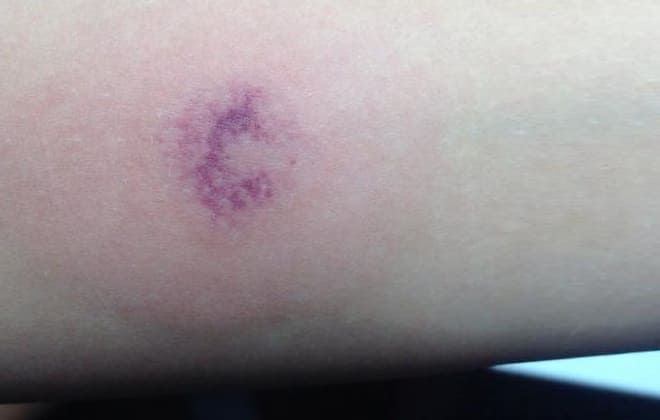
Such a reaction does not indicate blood poisoning. But to remove possible suspicions, you can consult a pediatrician and phthisiatrician.
You should also go to the hospital if the bruise has developed into a purulent abscess, accompanied by throbbing pain and dense swelling.
What do you think are the most important factors when choosing a medical facility? Poll Options are limited because JavaScript is disabled in your browser.
How to deal with blueness
A bruise after Mantoux can be removed only with the permission of a doctor. The following methods can be used:
- applying magnesium to the vaccination site;
- wrapping your hand in cling film;
- applying an iodine grid to the bruised area;
- placing a compress of chopped cabbage on the hematoma.
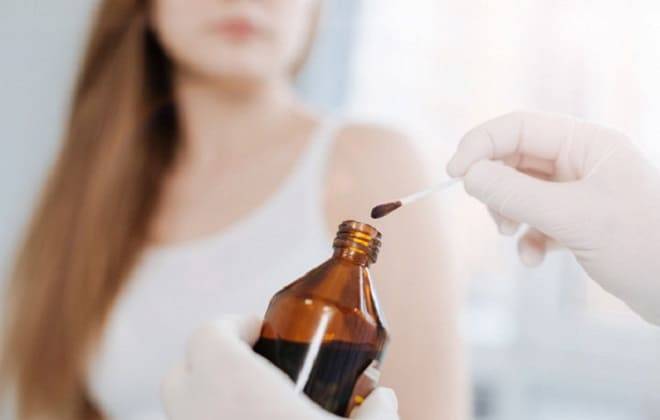
If none of the methods help, you need repeated consultation and help from a doctor.
If a bruise appears from Mantoux in combination with other side effects, such as fever or stomach upset, symptomatic treatment can be carried out, but only if they occur once. You can choose Ibuprofen or Paracetamol as an antipyretic.
How to prevent Mantoux from appearing blue in a child
Only a medical professional can prevent Mantoux from appearing blue in a child:
- use an aseptic solution when working;
- inject the tuberculin solution under the skin as slowly as possible;
- use only a disposable three-component syringe for manipulation;
- choose a thin needle and the required length;
- place the “button” in a specific place according to the execution technique.

And parents, immediately after performing the Mantoux test, can also take some actions that will prevent the formation of a bruise at the injection site:
- the area of the arm with the tuberculin injection site must be protected from water getting on it;
- do not allow scratching of the injection site, for which it is recommended to periodically wipe it with disinfectant solutions;
- do not apply a bandage or put a patch on the papule.
For 3 days after Mantoux, it is recommended to protect the child from possible allergens and adjust his diet. For example, it is recommended to give up chocolate, red vegetables and fruits, and citrus fruits.
We recommend reading about how many days after Mantoux is checked. From the article you will learn on what day the Mantoux vaccination is checked in small/adult children, how and on what day you can check it yourself. And here is more information about why the temperature rose after Mantoux vaccination.
A bruise after Mantoux does not pose a danger to the child’s health and does not indicate blood poisoning or the presence of the causative agent of tuberculosis (Koch bacillus) in the body. But a hematoma can lead to false diagnostic results (positive or negative), so the doctor may prescribe a second vaccination 8-12 weeks after the previous one.

